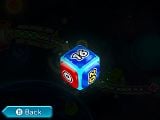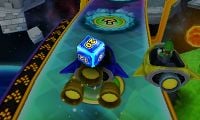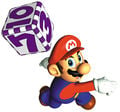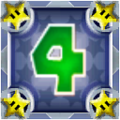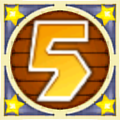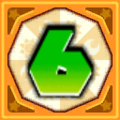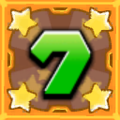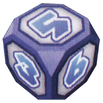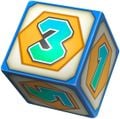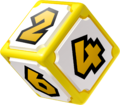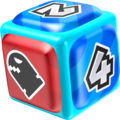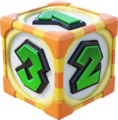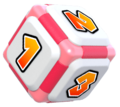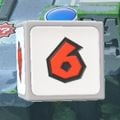Dice Block
- Not to be confused with Chance Cube.
- “First, let's decide the turn order. Press
 on the Wii Remote to hit the Dice Block.”
on the Wii Remote to hit the Dice Block.” - —Yellow Toad, Mario Party 9
In the Mario Party series, the Dice Block determines how many spaces a character must move. The player must "hit" the Dice Block and advance the number of spaces it shows. The Dice Block rolls from the number 1-10 (1-6 from Mario Party 9 onwards), or 1-5 when a Poison Mushroom or Slowgo Candy is active. In addition to moving the players, the block is also used to determine the turn order of the game before it starts, where all players hit the block, and whoever rolled the highest number goes first, and the player who rolled the lowest number goes last. Dice Blocks also appear in various minigames with various functions. At the end of the game, if there is a tie at any position, a Dice Block roll is used to break the tie. Since Mario Party 4, though, the tiebreaker is done only for the first place players. If the score is tied at the end of the minigame in Mario Party: Island Tour and Mario Party 10, then a Dice Block tiebreaker will determine the final results for that minigame.
There is also a volleyball version of the block in Mario Party 5's version of Beach Volley Folley where teams can get up to six points if the ball lands on the sand.
Since Mario Party 9, the normal Dice Block no longer goes up to ten, and now goes up to only six. In Mario Party 9, however, there is a Special Dice Block, which is the 1-10 Dice Block resembling a pentagonal bipyramid that allows for 1-10 movement, and in Mario Party: Island Tour, there are Bonus Dice Blocks that can be won by placing 1st, 2nd, or 3rd in a minigame for Bonus Dice Blocks.
The Dice Block from Mario Party 8 appears as a sticker in Super Smash Bros. Brawl, granting stronger arm attacks, while Mario's Dice Block from Super Mario Party appears as a support spirit in Super Smash Bros. Ultimate, which allows the user to escape grabs more easily. The spirit was originally exclusive to the "Oh Yeah! Mario Time!" spirit event that ran from December 27, 2018 to January 1, 2019, but was later made obtainable from the Spirit Board and Vault Shop following the version 2.0.0 update released on January 30, 2019.
Use
To hit the Dice Block, the player needs to press in most installments. In Mario Party 8, the
![]() is swung upwards. In Mario Party DS, the
is swung upwards. In Mario Party DS, the is used to tap the block. In Mario Party: Island Tour, the
![]() is used to throw the block into the game screen. In Mario Party 6 and Mario Party 7, the player can also use the mic to hit the block.
is used to throw the block into the game screen. In Mario Party 6 and Mario Party 7, the player can also use the mic to hit the block.
Types of Dice Blocks
There are also other types of Dice Blocks in the Mario Party series, as shown below:
- Plus Block: A blue dice block that allows the player to gain coins depending on the number the die shows once rolled (1-10).
- Minus Block: Deducts the number rolled from the player's coins (1-10). It's a red die.
- Slow Block: The player can only roll numbers from 1-3. It's an orange die.
- Speed Block: The player can only roll numbers from 8-10. It's a green die.
- Hidden Block: This block may appear on the space the player lands on after taking their turn, and gives the player the opportunity to gain coins, an item, a Star, or a Ztar. A brown or silver die.
- Halfway Dice Block: This is a dice block that is numbered only 1-5. It is found in Mario Party DS only.
- Warp Dice Block: When the player uses it in Mario Party DS, then they will teleport to a random space before rolling the normal one.
- Event Block: In Mario Party, Boo, Koopa Troopa, or Bowser will appear from this block. Boo will steal Coins and Stars from another player, Koopa Troopa gives the player 20 coins, and Bowser takes away the same amount of coins that Koopa Troopa gives to the player.
- Cursed Block: After using a Cursed Mushroom, the die turns purple making the player only use the numbers 1, 2 or 3 (in Mario Party 5's Card Party and Mario Party 6's Solo Mode) or 1-5 used as a regular item. Powerful when using against others and also useful to avoid spaces or areas.
- Reverse Block: In Mario Party 3, after using a Reverse Mushroom, this die makes the player go backwards.
- Sluggish Block: In Mario Party 6 and Mario Party 7, after using the Slow 'Shroom Orb (In Mario Party 8, it is a Slowgo Candy), players can roll any number they want (in Mario Party 8 it only shows the numbers 1-5) but they need to jump up one number before the one they want because they jump slowly. The Sluggish Block re-appears in Mario Party 9 and is golden. It's even slower than in the other games, so the player does not have to jump one number before.
- Red Block: After using a Mushroom, Mushroom Orb, or Twice Candy, the player gets to roll twice, giving them up to twenty spaces to move.
- Golden Yellow Block: After using a Golden Mushroom, Super 'Shroom Orb, Thrice Candy, or Triple Dice Set, the player can roll three times, giving them up to thirty spaces to move.
- Green Block: After using a Slowgo Candy in Mario Party 8, the block will slow down and the player hits a slower Dice Block with the numbers 1-5. It re-appears in Mario Party 9 but due to the new limits of the regular Dice Block, the limits of this special Dice Block is lowered to the range of 1-2-3 (known as the 1-2-3 Dice Block). In Mario Party Advance, if the player lands on a Dice Block space, they can roll again with a green-colored Dice Block instead of a blue one like it normally is (Rolling in Mario Party Advance costs one Mushroom).
- Mega Block: If a player used a Mega Mushroom or a Super Mega Mushroom in Mario Party 4, then the player can grow and squish anyone that stands in the way while rolling twice or thrice.
- Mini Block: If a player used a Mini Mushroom or a Super Mini Mushroom in Mario Party 4, then the player can shrink and walk through small pipes while rolling once or twice.
- Elevator Block: This block advances the player to a higher floor in the minigame Bowser's Lovely Lift! in Mario Party 7. A black die.
- Dice Barrel: When a DK Bonus occurs in Mario Party 6, Donkey Kong will let the player get coins or a star with a hit of a barrel.
- Star Block: If this item is activated in Mario Party DS, it will add one, two or three stars to the player's total.
- 1-2-3 Dice Block: This special Dice Block from Mario Party 9 and Mario Party 10 allows the player to move 1-3 spaces.
- 4-5-6 Dice Block: This special Dice Block from Mario Party 9 and Mario Party 10 guarantees movement within the range of 4-6.
- 0-1 Dice Block: This special Dice Block from Mario Party 9 and Mario Party 10 guarantees movement within the range of 0-1.
- 1-10 Dice Block: This special Dice Block from Mario Party 9 looks drastically different from regular Dice Blocks, and instead looks like an actual 10-sided die. It allows the player to roll anywhere from 1-10. While Dice Blocks in most Mario Party games allow this, Mario Party 9 is an exception with the standard Dice Block being a typical six-sided die.
- 1-2-3 Slow Dice Block: This special Dice Block from Mario Party 10 allows the player to choose to move 1-3 spaces.(Only available in Bowser Party mode)
- Slow Dice Block: This special Dice Block from Mario Party 9 and Mario Party 10 allows the player to choose to move 1-6 spaces.
- Gold Dice Block: This Bonus Dice Block from Mario Party: Island Tour allows the player to roll between two and twelve spaces. Received to the player who finishes a minigame for Bonus Dice Blocks in first place.
- Silver Dice Block: This Bonus Dice Block from Mario Party: Island Tour allows the player to roll between two and nine spaces. Received to the player who finishes a minigame for Bonus Dice Blocks in second place.
- Bronze Dice Block: This Bonus Dice Block from Mario Party: Island Tour allows the player to roll between two and eight spaces. Received to the player who finishes a minigame for Bonus Dice Blocks in third place.
- Custom Dice Block: This Dice Block from Mario Party: Island Tour allows the player to roll any number of their choice.
- Bowser Dice Block: This Dice Block allows the players to remain where they are instead of getting burnt to move to other spaces as long as their roll is doubled. It only appears in Bowser's Peculiar Peak. In Mario Party 10, this is used during Bowser Party. Bowser starts his turn with four blocks and it can be used to catch up to the team.
- Double Dice Block: Appearing in Mario Party 10 and Mario Party DS by using a Double Dice Set, this Dice Block allows the player to roll twice.
- Reverse Dice Block: Appearing in Mario Party 10, this Dice Block allows the player to move backward 1-6 spaces.
- Coin Dice Block: Appearing in Mario Party 10, this Dice Block allows the player to get coins from 1-6. Found only in the Wario amiibo board.
Designs
In Mario Party games from the Hudson Soft era, all Dice Blocks are rolled similar to Roulette Blocks with numbers from 1 to 10.
- Mario Party: The dice block has a white and black squared pattern frame. The numbers are purple to blue.
- Mario Party 2: The dice has a silver color with white octagons around the numbers. The numbers have the same color as the first.
- Mario Party 3: On the background on the dice, the border is brown, and in the center of the dice, the color is creme with brown stars. The numbers are blue and in a different font.
- Mario Party 4: The dice block has a lavender face and silver border. On each face, four Stars are shown. The numbers are green.
- Mario Party 5: The dice block has a violet face and lavender border. Around each face of the dice, there are four little stars, and there is a brown wooden background between a creme circular border. The numbers are orange.
- Mario Party 6: The dice block has an orange border. On each face of the dice, a creme octagon has a pattern of moons and stars. The numbers are green.
- Mario Party Advance: The dice block is basically blue (green if landed on a Dice Space), and it has white numbers.
- Mario Party 7: The dice block has an orange border, and on each face, four stars are shown in a brown background. The numbers are green.
- Mario Party 8: The dice block is a round-cornered dice this time. It has a blue border and it has a gray octagon background on the face. The numbers are blue.
- Mario Party DS: The dice block has a blue border, a creme background inside the face, and an orange hexagon. The numbers are blue to green.
From Mario Party 9 onwards, Dice Blocks are rolled similar to regular dice, and normal ones have numbers from 1 to 6.
- Mario Party 9: The dice block has a yellow border, and it has white octagons on each face. The numbers are yellow and in a different font.
- Mario Party: Island Tour: The dice block has a cyan border, and has a blue face. The numbers are white like in Mario Party Advance. As well, some boards have slight changes to the block; on Rocket Road each dice is numbered 0-5 (with the number five being colored yellow and the zero face colored red), on Banzai Bill's Mad Mountain they are numbered 1-5 with the sixth side featuring a red face and a picture of a Banzai Bill that causes a board event and in Bowser's Peculiar Peak, there are red faces with spikes added.
- Mario Party 10: Same as Mario Party 9, but the border is striped, and numbers are colored green instead of yellow.
- Mario Party: Star Rush / Mario Party: The Top 100: The dice block is white and has a border that is colored after the player's color (red for player 1, blue for player 2, yellow for player 3 and green for player 4). The actual characters have a border matching their signature color (red for Mario, dark green for Luigi etc). The numbers are orange to red.
- Super Mario Party: The dice block is white and has a cyan border. The numbers are colored depends on the player's turn order (red for first, blue for second, green for third and orange for fourth). The character-specific dice blocks have a border matching their signature color, similar to non-Toad dice blocks in Mario Party: Star Rush. Additionally, the dice blocks for Bowser's minions have a spiked trim.
Official profiles
Super Smash Bros. series
Super Smash Bros. Brawl sticker
| Image | Artwork from | Effect in The Subspace Emissary |
|---|---|---|

|
Mario Party 8 | [Arm] - Attack +8 Usable by: Mario, Luigi, Yoshi, Peach, Bowser |
Super Smash Bros. Ultimate spirit
| Name | Image | Series / game | Type | Class | Strength / effect(s) | How to obtain | Spirit battle | |||
|---|---|---|---|---|---|---|---|---|---|---|
| Opponent(s) | Battle conditions | Stage | Song | |||||||
| Dice Block | 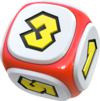
|
Super Mario Series | Support (1) | Novice | Improved Escape | Spirit Board (ver. 2.0.0 or later) | Mario, Peach | Rule: Item Tidal Wave (Crates)
|
Princess Peach's Castle | Pandemonium |
Mario Party 10
- Instruction manual: "Has numbers from 1 to 6."
Gallery
Mario Party artwork.
Mario Party: Island Tour (Perilous Palace Path, Star-Crossed Skyway)
Mario Party: Island Tour (Banzai Bill's Mad Mountain)
Mario Party: Island Tour (Rocket Road)
Names in other languages
| Language | Name | Meaning |
|---|---|---|
| Japanese | サイコロ (Mario Party to Mario Party 8) Saikoro ノーマルサイコロ (Mario Party 9 onwards) Nōmaru saikoro |
Dice Normal Dice |
| Dutch | Dobbelblok |
Dice Block, portmanteau of Dobbelsteen (Dice) and Blok (Block) |
| German | Würfel-Block |
Dice Block |
| Russian | Кубик Kubik |
Block |
| Spanish | Bloque de Dados Dado |
Dice Block Dice |
Trivia
- In Mario Party 9, Mario Party 10 and Mario Party: Island Tour, the Dice Block rolls like dice in real life, but in the first eight Mario Party games, the block either breaks apart like Brick Blocks or disappear.
- Shaking the
 in Mario Party 9 and Mario Party 10 causes the Dice Block to grow larger and spin faster. This also applies to amiibo Party mode, but by holding down the amiibo.
in Mario Party 9 and Mario Party 10 causes the Dice Block to grow larger and spin faster. This also applies to amiibo Party mode, but by holding down the amiibo.
- Shaking the
- In Mario Party games that are played based on the number of turns, the first turn of a game (hitting the Dice Block) along with the fifth-to-last turn (Last Five Turns Event) are the only two turns that begin with an event before the players can move.
- In Mario Party DS, as with some previous installments, the number that will show up on the Dice Block is pre-determined at the start of the current player's turn. However, the game can be forced to reselect the number should the player bring up the Dice Block and then reopen the item menu.
- Dice Blocks
- Mario Party Items
- Mario Party 2 Items
- Mario Party 3 Items
- Mario Party 4 Items
- Mario Party 5 Items
- Mario Party 6 Items
- Mario Party 7 Items
- Mario Party 8 Items
- Mario Party 9 Items
- Mario Party 10 Items
- Mario Party Advance Items
- Mario Party DS Items
- Mario Party: Island Tour Items
- Mario Party: Star Rush Items
- Super Mario Party Items
- Super Smash Bros. Brawl Stickers
- Super Smash Bros. Ultimate Spirits
